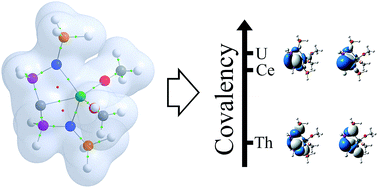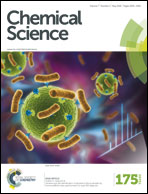Emergence of comparable covalency in isostructural cerium(iv)– and uranium(iv)–carbon multiple bonds†
Abstract
We report comparable levels of covalency in cerium– and uranium–carbon multiple bonds in the iso-structural carbene complexes [M(BIPMTMS)(ODipp)2] [M = Ce (1), U (2), Th (3); BIPMTMS = C(PPh2NSiMe3)2; Dipp = C6H3-2,6-iPr2] whereas for M = Th the M![[double bond, length as m-dash]](https://www.rsc.org/images/entities/char_e001.gif) C bond interaction is much more ionic. On the basis of single crystal X-ray diffraction, NMR, IR, EPR, and XANES spectroscopies, and SQUID magnetometry complexes 1–3 are confirmed formally as bona fide metal(IV) complexes. In order to avoid the deficiencies of orbital-based theoretical analysis approaches we probed the bonding of 1–3via analysis of RASSCF- and CASSCF-derived densities that explicitly treats the orbital energy near-degeneracy and overlap contributions to covalency. For these complexes similar levels of covalency are found for cerium(IV) and uranium(IV), whereas thorium(IV) is found to be more ionic, and this trend is independently found in all computational methods employed. The computationally determined trends in covalency of these systems of Ce ∼ U > Th are also reproduced in experimental exchange reactions of 1–3 with MCl4 salts where 1 and 2 do not exchange with ThCl4, but 3 does exchange with MCl4 (M = Ce, U) and 1 and 2 react with UCl4 and CeCl4, respectively, to establish equilibria. This study therefore provides complementary theoretical and experimental evidence that contrasts to the accepted description that generally lanthanide–ligand bonding in non-zero oxidation state complexes is overwhelmingly ionic but that of uranium is more covalent.
C bond interaction is much more ionic. On the basis of single crystal X-ray diffraction, NMR, IR, EPR, and XANES spectroscopies, and SQUID magnetometry complexes 1–3 are confirmed formally as bona fide metal(IV) complexes. In order to avoid the deficiencies of orbital-based theoretical analysis approaches we probed the bonding of 1–3via analysis of RASSCF- and CASSCF-derived densities that explicitly treats the orbital energy near-degeneracy and overlap contributions to covalency. For these complexes similar levels of covalency are found for cerium(IV) and uranium(IV), whereas thorium(IV) is found to be more ionic, and this trend is independently found in all computational methods employed. The computationally determined trends in covalency of these systems of Ce ∼ U > Th are also reproduced in experimental exchange reactions of 1–3 with MCl4 salts where 1 and 2 do not exchange with ThCl4, but 3 does exchange with MCl4 (M = Ce, U) and 1 and 2 react with UCl4 and CeCl4, respectively, to establish equilibria. This study therefore provides complementary theoretical and experimental evidence that contrasts to the accepted description that generally lanthanide–ligand bonding in non-zero oxidation state complexes is overwhelmingly ionic but that of uranium is more covalent.



 Please wait while we load your content...
Please wait while we load your content...